Chromosome movement in mitosis and meiosis Assignment Help
Mitosis is also called equational division since the chromosome is equally divided between daughter cells. This division takes place in somatic cells of the body whereas meiosis is called reductional division since daughter cell receive half the number of chromosome than the parent cell and this division is important in germ cells of the body.
Mitosis is divided into different stages and in these stages is marked by the changes in the chromosomes. So, in the first stage of mitosis called prophase; chromosomes are condensed and can be visualized properly like the strands of thread. They are composed of two sister chromatids that are attached to each other at centromere. The random distribution of chromosome is the result of attachment of spindle microtubules to the chromosomal kinetochores. The next stage is metaphase where chromosomes that are condensed during prophase get aligned to form the metaphasic plate. Therefore, chromosomes at this stage will look stable and well aligned and hence can be differentiated on the basis of size and shape. This proper alignment of chromosome occurs due to the pulling and pushing forces that moves the chromosome towards the pole and away from the spindle pole respectively. Next is the anaphase stage, also the shortest stage among the all. At this stage the sister chromatids of each chromosome separate and start to move towards the opposite poles of the cell. in this stage of mitosis, one noticeable things is that firstly chromosome are pulled towards the opposite poles and secondly the poles also starts moving away from each other, hence these are named anaphase A and anaphase B respectively. This movement of chromosome is guided by three separate group of protein that operates at plus end of kinetochore microtubules, polar microtubules and astral microtubules respectively and the contribution of all these proteins results in pulling and pushing force that help in the separation of chromosome during anaphase. Finally is the last stage if mitosis, telophase stage in which the daughter chromosome is receives at the poles of the spindle. Therefore, chromosomes become uncoil like that of interphone stage and hence the cycle continues.

Chromosome movement in mitosis and meiosis Assignment Help Through Online Tutoring and Guided Sessions from AssignmentHelp.Net
Image reference: www.kc.njnu.edu.cn.com
Like that of mitosis, meiosis is also divided into two main stages, called meiosis 1 and meiosis 2. Meiosis 1 is divided into four main stages that are prophase, metaphase, anaphase and telophase and similar is the case with meiosis 2. The differences between these two stages are that in meiosis one, the number of cell is doubled whereas meiosis 2 is completely same like that of mitosis. Now prophase of meiosis is again divided into different stages like leptosome, in this case the chromosome gets condensed and becomes visible and along with this, homologous pairing of chromosome also takes place at this stage. Second is the zygotene, in this stage the condensation of chromosome increases forming synaptonemal complex. Third is the pachytene where chromosomes becomes short and forms the tetrad. Fourth is the diplotene where crossing over takes [lace between the non- sister chromatid. Final is the diakinesis when chromosome still continues to move apart. Then is the metaphase 1, when homologous pair of chromosome aligns at the center. Third is the anaphase 1 when homologous chromosomes separate and finally is the telophase 1 that is almost absent in most species. Beside this, meiosis 2 is completely like that of mitosis that involves lining of chromosome in the equatorial plate, then comes anaphase 2 where chromosomes are separated and moves to the opposite pole and finally is the telophase 2 where daughter cells are formed.
This chromosomal pairing and movement gets accomplished in meiosis. Both this process is important for proper functioning of cell and normal body functioning because cell cycle is incomplete without mitosis and meiosis. This process also leads to DNA replication and many more of the associated cycles. Hence, continuity can be maintained with this phase of cell cycle. If any problem or obstruction comes in between the process of mitosis and meiosis, there can be several negative drawbacks or result. Therefore, it is very important to understand the underlying process of division.


